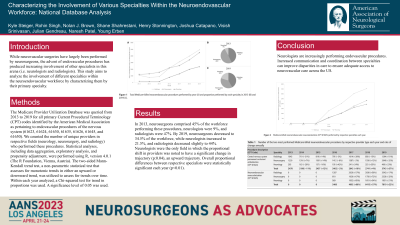Characterizing the Involvement of Various Specialties Within the Neuroendovascular Workforce: National Database Analysis
Friday, April 21, 2023


Nolan J. Brown, MBA
Junior Specialist
UC Irvine Department of Neurosurgery
Santa Clarita, California, United States
ePoster Presenter(s)
Introduction: While neurovascular surgeries have largely been performed by neurosurgeons, the advent of endovascular procedures has produced increasing involvement of other specialists in this arena (i.e. neurologists and radiologists). How this rapidly developing field has been progressing in terms of
This study aims to analyze the involvement of different specialties within the neuroendovascular workforce by characterizing them by their primary specialty.
Methods: The Medicare Provider Utilization Database was queried from 2013 to 2019 for all primary Current Procedural Terminology (CPT) codes identified by the American Medical Association as pertaining to endovascular procedures of the nervous system (61623, 61624, 61630, 61635, 61626, 61645, and 61650). We counted the number of unique providers in respective fields (neurology, neurosurgery, and radiology) who performed these procedures. Statistical analyses, including data aggregation, exploratory analysis, and propensity adjustment, were performed using R, version 4.0.1 (The R Foundation, Vienna, Austria). The two-sided Mann-Kendall trend test, a non-parametric statistical test that assesses for monotonic trends in either an upward or downward trend, was utilized to assess for trends over time. Within each year analyzed, a Chi-squared test for trend in proportions was used. A significance level of 0.05 was used.
Results: In 2013, neurosurgeons comprised 45% of the workforce performing these procedures, neurologists were 9%, and radiologists were 47%. By 2019, neurosurgeons decreased to 34.5% of the workforce, while neurologists increased to 21.5%, and radiologists decreased slightly to 44%. Neurologists were the only field in which the proportional shift in providers was noted to have a significant change in trajectory (p:0.04), an upward trajectory. Overall proportional differences between respective specialists were statistically significant each year (p < 0.01).
Conclusion : Neurologists are increasingly performing endovascular procedures. Increased communication and coordination between specialties can improve disparities in care to ensure adequate access to neurovascular care across the US.
This study aims to analyze the involvement of different specialties within the neuroendovascular workforce by characterizing them by their primary specialty.
Methods: The Medicare Provider Utilization Database was queried from 2013 to 2019 for all primary Current Procedural Terminology (CPT) codes identified by the American Medical Association as pertaining to endovascular procedures of the nervous system (61623, 61624, 61630, 61635, 61626, 61645, and 61650). We counted the number of unique providers in respective fields (neurology, neurosurgery, and radiology) who performed these procedures. Statistical analyses, including data aggregation, exploratory analysis, and propensity adjustment, were performed using R, version 4.0.1 (The R Foundation, Vienna, Austria). The two-sided Mann-Kendall trend test, a non-parametric statistical test that assesses for monotonic trends in either an upward or downward trend, was utilized to assess for trends over time. Within each year analyzed, a Chi-squared test for trend in proportions was used. A significance level of 0.05 was used.
Results: In 2013, neurosurgeons comprised 45% of the workforce performing these procedures, neurologists were 9%, and radiologists were 47%. By 2019, neurosurgeons decreased to 34.5% of the workforce, while neurologists increased to 21.5%, and radiologists decreased slightly to 44%. Neurologists were the only field in which the proportional shift in providers was noted to have a significant change in trajectory (p:0.04), an upward trajectory. Overall proportional differences between respective specialists were statistically significant each year (p < 0.01).
Conclusion : Neurologists are increasingly performing endovascular procedures. Increased communication and coordination between specialties can improve disparities in care to ensure adequate access to neurovascular care across the US.
